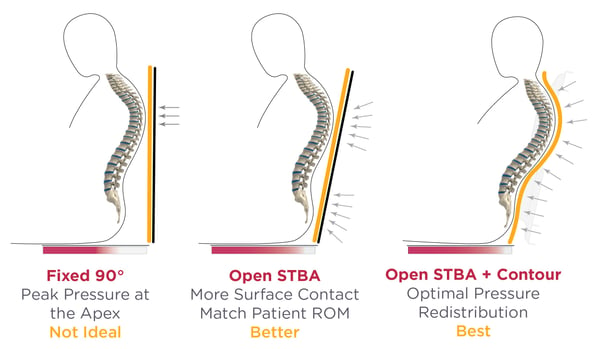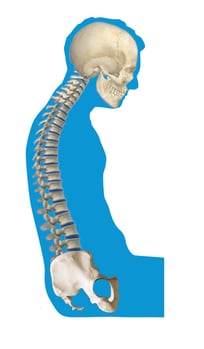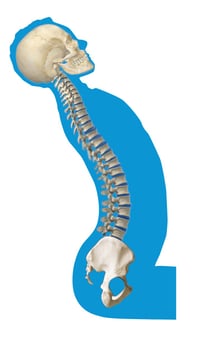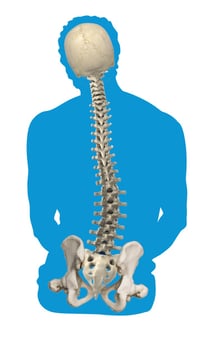Part 10 in our Pressure Management Guide series. See Part 1, Part 2, Part 3, Part 4, Part 5, Part 6, Part 7, Part 8, and Part 9. Check out our comprehensive, digital Pressure Management Guide.
Is your spine flat? Of course not! We have natural curvature to our spine and need to support it so it doesn’t flatten out or progress into an abnormal curvature.
Patients at risk for pressure injuries often present with an abnormal curvature of the spine that has become their “normal.” If we allow patients to sit on sling backs or straight back chairs, that cannot mimic their now “normal” shape, dagger-like pressure will enter only at the apex of the curvature.
Specialized back supports allow for immersion and envelopment of abnormal curvatures, which will protect the spine from peak pressures. Let’s quickly review what the abnormal postures look like:
|
Kyphosis
|
Lumbar Lordosis
|
|
Scoliosis
|
Spinal Rotation
|
So, we need to support these now “normal” curvatures to either correct them or prevent them from getting worse and to protect the individual from developing a pressure injury. We can achieve this by utilizing back supports that conform, envelop, and immerse the spine.
How does utilizing a back support with immersion and/or envelopment properties help prevent a pressure injury?
- Allows for optimal contact with seat and back support surface
- Provides even pressure redistribution along the spine
- Reduces shear forces by maximizing stability of the spine and, in turn, the pelvis to prevent unwanted movement in the chair
We discussed in last week’s blog the importance of adjusting seat-to-back-angle (STBA) and how in many cases we should be opening STBA in order to facilitate better contact with the seat support, increase stability, and reduce peak pressures. However, let’s take it one step further!
Look at the difference you can make in the amount of contact with the support surfaces–even after opening the STBA–when using a back support that can envelop the spine.

As the therapist, consider the individual’s range of motion (ROM), muscle integrity, and joint integrity. Take a measurement of the tolerable hip ROM that would dictate the STBA and adjust the chair accordingly.
- Open or close the seat-to-back angle to accommodate for your patient’s degree of hip ROM and reduce the likelihood of them sliding into an abnormal posture.
- Change seat-to-back angle to allow for more contact with the back support and seat surface and reduce peak pressures.
- Use a back support that conforms to the patient’s curvature for maximum pressure redistribution along the ENTIRE spine.

To recap the benefits of using an adjustable back support to optimize posture and prevent a pressure injury:
- Immerse and envelop the spine for optimal contact.
- Capture the curvature whether normal or abnormal for optimal upright, midline posture.
- Allow for even pressure redistribution to alleviate peak pressures along the spinous processes.
- Allow for the addition of lateral trunk and head supports to decrease the likelihood of abnormal postures that increase risk of a pressure injury.
- Replace an overstretched, hammocking sling back that has lost its shape and can no longer stabilize the trunk as needed.
REMEMBER, the appropriate back support is an essential part of the optimal seating system when managing falls and pressure injuries!
Want to learn more about pressure management and the prevention of pressure injuries? See our comprehensive digital Pressure Management Guide.

Ana Endsjo, MOTR/L, CLT
Clinical Education Manager LTC Division
Ana Endsjo has worked as an occupational therapist since 2001 in a variety of treatment settings. She has mainly worked with the geriatric population, dedicated to the betterment of the treatment of the elderly in LTC centers. Her focus has been on seating and positioning and contracture management of the nursing home resident. With this experience, her hope is to guide other therapists, rehab directors, nurses, and administrators through educational guides, blogs, webinars, and live courses in her role as Clinical Education Manager for the long term care division.





